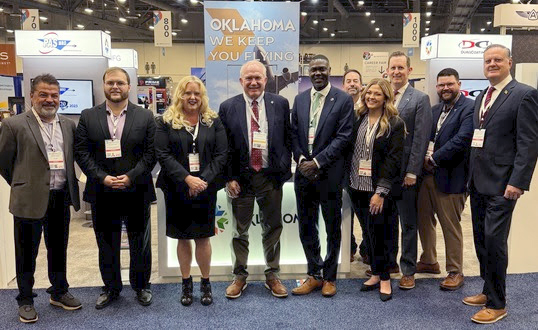Photo above – From left are, George Flores, PAS MRO; Walter Baker, Oklahoma Commerce (Commerce); Sandra Shelton, Oklahoma Aerospace and Aeronautics (ODAA); Senator John Haste; Aldwyn Sappleton, Commerce; Scott Keith, Will Rogers International Airport; Katelyn Wade, ODAA; Grayson Ardies, ODAA, Nick Young, ODAA, and Brent Wright, Commerce.
The state of Oklahoma was represented by the Oklahoma Department of Commerce and the Oklahoma Department of Aerospace and Aeronautics at the 2024 National Business Aviation Association conference which showcases the critical business aviation segment of the industry including many new advanced air mobility (AAM) technologies. The state’s presence also included key aerospace partners from OKC Will Rogers International Airport, Tulsa Airport Improvement Trust, MST Manufacturing, and PAS MRO.
The timing of the conference comes as the state released their advanced mobility strategy this past summer to build an ecosystem to support the adoption of new transportation technologies. With Oklahoma looking to both attract the future of aviation and build upon our legacy of being the MRO capitol of the world it is opportunities provided by the NBAA-BACE that allow the state to showcase its capabilities to companies on a global landscape.
As advanced air mobility (AAM) developers begin to see certification and operations come into focus, attention is shifting now to answering critical questions about how to bring these new aircraft to market. Oklahoma is primed to take advantage of these new technologies with its significant aerospace industry presence, vast state, academic, tribal, and community partners and a top-tier workforce pipeline to support the creation of job opportunities to benefit all Oklahomans.
Several of the aviation industry’s most important AAM and fixed base operator executives gathered to discuss innovative, low-emissions platforms that are now emerging across the world. At the Newsmaker luncheon, Senator John Haste along with Executive Director Grayson Ardies with the Oklahoma Department of Aerospace and Aeronautics and several other Oklahoma partners, were invited to listen in on how these new and exciting entrants are setting the stage for the future of aviation.
“Sitting at a table of experts and industry professionals to include executives with BETA Technologies, Electra, Lilium, Atlantic Aviation, Signature Aviation, and a journalist from the aviation news service, The Air Current, I listened earnestly, and soon realized, this is an 1889 type of moment, and aviation is for everyone. AAM is going to be the next land rush, only the skies will be the new territory that companies are looking to stake their claim in,” said Haste. “With Oklahoma being the 20th largest state, with nearly 70,000 square miles of airspace, we are well-positioned for exploratory technologies and advanced air solutions.” The conference professional panel emphasized that the aviation industry had already started developing the necessary ground infrastructure to sustain AAM passenger aircraft operations, including charging stations and other equipment needed for battery enabled propulsion systems. Now the question is how to make these technologies and their support systems scalable and bring about the adoption of AAM at a much faster pace.
“NBAA-BACE is a unique conference opportunity to mix and converge two very important segments of the industry: the foundation of what NBAA is built upon with business aviation and corporate aircraft transportation with the new up-and-coming technologies such as advanced air mobility vehicles. Meeting with the variety of companies that are at this event and seeing their strategic visions for the future showcases why it is critical for Oklahoma to continue to invest in new infrastructure technologies that will enable the future of the aerospace industry,” said Ardies.
Oklahoma is actively working on engaging the public with the opportunities presented with the future of electric flight. Both the government and private sectors have started to take advantage of UAS/AAM and will continue to do so as the regulatory environment at the federal level permits.



